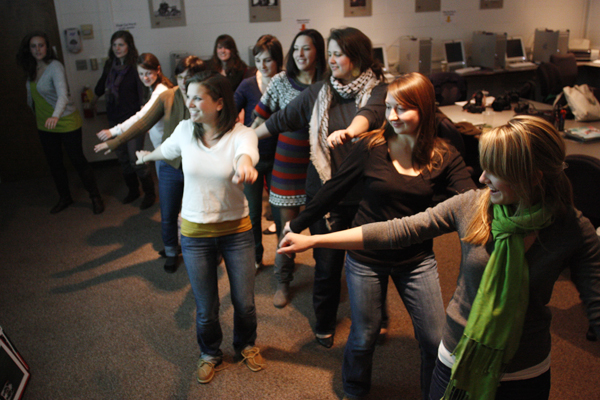Okay, enough games. The reason for Part 1 of this post was to point out a problem I frequently run into in the course of covering news -- that of corporate policies towards the news media.
My goal Monday was to inform and show public interest in the opening of a new restaurant in town. While I was greeted cordially by the general manager at Olive Garden®, I was also informed that I would need to stay in the front welcome area, and that their policy was to not allow their patrons to be photographed. Of course, they were the only reason I was there. He said he would double check.
He went into the back and returned with a gentleman dressed out in an executive chef-type outfit. I assumed he was one of those consultant-types from the corporate headquarters that specializes in getting new restaurants off the ground and making sure that they conformed to company standards. He repeated that the company policy was not to let patrons be photographed.
Now, I can understand this to an extent. But my intent was not to rush in like Rambo and make pictures paparazzi-style. "Well, I think it's important to show public interest in your restaurant's opening," I said. "What if I asked permission before I made any pictures of customers?"
The man simply shook his head "no."
Hmmmmm. "How 'bout this? Again, to show public interest, what if I photographed customers from the back - so that they are unidentifiable - with your staff waiting on them?" I implored.
This time, Chef Stick-to-the-Rules rolled his eyes, shook his head "no" again, and said "I suggest you take pictures on the outside of the restaurant."
A little frustrated, I responded "Well, that's not news. People have been looking at the outside of this restaurant for months."
He simply shrugged, turned, and left me once again with the general manager, who had no objections to me photographing the staff welcoming customers in the front, just as long as I didn't show any customers, who were now streaming in steadily.
So I was left to my own creative devices to make an interesting picture, albeit one that really didn't give our readership an accurate representation of the event.
I detailed this encounter because it's one I frequently run into. Local businesses tend to welcome coverage from their local newspaper. However, local extensions of big corporations or chain franchises are rather balky, to say the least, when it comes to coverage. Their mostly inflexible policies towards news media reflect suspiciousness and outright disdain. Local managers who wouldn't mind some coverage of their establishments usually decline anyway, either in fear of making situational exceptions to corporate policy or having to navigate their way up the corporate ladder themselves seeking permission.
Remember the adage "bad publicity is better than no publicity?" Well, the opposite of that tends to be standard practice in the business world these days. That is to say, no publicity is better than an infinitesimal chance of some perceived less-than-positive spin on a story or some chance of a crazy, frivolous law suit.
I've had construction companies decline coverage because of some fear that OSHA might spot some minor infraction in their workplace. I've had some business managers insist on approving any photograph before it is published (which would constitute prior restraint, or censorship, folks). One time, the manager at another national restaurant chain here in Statesboro objected when I took pictures of their establishment when they were performing exterior renovations, in plain public view. He was concerned that a picture would make people think the restaurant was closed. I had to explain that most people driving past would assume that they were indeed closed, but that a picture with a caption would explain they were still open and give a time frame for the completion of the project. It was really a public service to the restaurant, one that answered questions from a public curious about a popular restaurant.
Companies -- even public institutions, in fact -- carefully guard their image and seek to control any information disseminated about them. This is understandable -- to a point. It's the right of a privately owned company to operate in their own interests. However, don't companies that primarily serve the public have an obligation to operate with
some amount of transparency?
I've tried to gain access to some companies which are essentially public gathering areas, but I have been banned and threatened for simply wanting to make photographs for stories about things like school supplies and holiday shopping. When I've tried to go through proper corporate avenues to gain permission, I've either been ignored or put off so long that story deadlines have passed. And, ironically, I have received press releases from these very same companies requesting coverage of their presentation ceremonies for charitable contributions.
Granted, it hurts a journalist's argument that they represent public interest when so many are employed by mega media corporations, some of whose business practices appear to run
counter to public interest. Irony abounds and it hurts journalists with honest intentions, and it sometimes hinders the flow of information the public needs to know what's going on in their own communities.
Apparently, I am a scary monster behind the camera, but I am most welcomed when I cross the threshold with my wallet opened and my mouth shut.
Most of the time, these restrictions are mostly an annoyance for me. But don't blanket bans on media coverage make you wonder what goes on behind closed doors?
The debate about public vs. private interests will probably always rage on. When and where does one trump the other? How do we maintain a proper balance?
Thoughts?












 Lorem ipsum dolor sit amet, consectetuer adipiscing elit. Quisque sed felis. Aliquam sit amet felis. Mauris sem
Lorem ipsum dolor sit amet, consectetuer adipiscing elit. Quisque sed felis. Aliquam sit amet felis. Mauris sem





